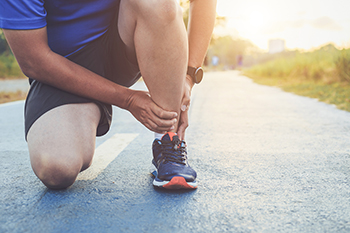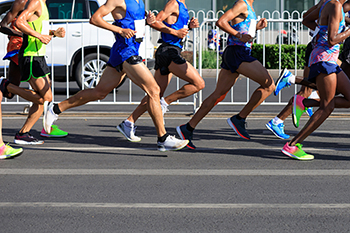July 2023
Symptoms of Tarsal Tunnel Syndrome

Tarsal tunnel syndrome is a foot condition that can be painful. The tibial nerve is found inside the tarsal tunnel, and an injury can cause this nerve to become compressed. It may also occur from having an abnormal foot structure, such as flat feet or a bone spur. The tibial nerve is located in the ankle and allows movement and feeling in various parts of the foot. The tarsal tunnel lies in the back of the inside of the ankle, and when this nerve is irritated in this narrow tunnel, tarsal tunnel syndrome can develop. Some of the symptoms that are associated with this foot condition can consist of a tingling or numbing sensation on the sole of the foot, and the toes may be difficult to move. Treatment generally begins with resting the foot and eliminating any activities that can cause discomfort. Some patients choose to wear orthotics, which may help reduce some of the symptoms. If the pain is severe and daily activities are difficult to accomplish, surgery may be an option to enlarge the tarsal tunnel. If you have this syndrome, it is suggested that you visit a podiatrist who can guide you toward the treatment that is best for you.
Tarsal tunnel syndrome can be very uncomfortable to live with. If you are experiencing tarsal tunnel syndrome, contact the podiatrists of New England Family Foot Care. Our doctors can provide the care you need to keep you pain-free and on your feet.
Tarsal Tunnel Syndrome
Tarsal tunnel syndrome, which can also be called tibial nerve dysfunction, is an uncommon condition of misfiring peripheral nerves in the foot. The tibial nerve is the peripheral nerve in the leg responsible for sensation and movement of the foot and calf muscles. In tarsal tunnel syndrome, the tibial nerve is damaged, causing problems with movement and feeling in the foot of the affected leg.
Common Cause of Tarsal Tunnel Syndrome
- Involves pressure or an injury, direct pressure on the tibial nerve for an extended period of time, sometimes caused by other body structures close by or near the knee.
- Diseases that damage nerves, including diabetes, may cause tarsal tunnel syndrome.
- At times, tarsal tunnel syndrome can appear without an obvious cause in some cases.
The Effects of Tarsal Tunnel Syndrome
- Different sensations, an afflicted person may experience pain, tingling, burning or other unusual sensations in the foot of the affected leg.
- The foot muscles, toes and ankle become weaker, and curling your toes or flexing your foot can become difficult.
- If condition worsens, infections and ulcers may develop on the foot that is experiencing the syndrome.
A physical exam of the leg can help identify the presence of tarsal tunnel syndrome. Medical tests, such as a nerve biopsy, are also used to diagnose the condition. Patients may receive physical therapy and prescriptive medication. In extreme cases, some may require surgery.
If you have any questions please feel free to contact our office located in Milton, MA . We offer the newest diagnostic and treatment technologies for all your foot and ankle needs.
How the Feet Work and Move

There is an intricate process that occurs between bones, muscles, tendons, and ligaments that allow people to stay on their feet and move through a variety of activities with grace and efficiency. The study of how the feet work and move and why they might not function properly is referred to as foot biomechanics. The bones in the different parts of the feet are connected by joints that allow a balance of stability and mobility. The arches of the feet act as natural shock absorbers and distribute forces exerted on the feet during movement. The muscles in the feet and lower legs work together to aid propulsion. By understanding the biomechanics of how the feet work and move, valuable insights can be used to improve footwear design. Also, helpful interventions and treatments can be developed to improve foot health, enhance athletic performance, and prevent injuries. If you would like to learn more about the biomechanics of the feet and how it can help you specifically, it is suggested that you make an appointment with a podiatrist to discuss this matter further.
If you have any concerns about your feet, contact the podiatrists from New England Family Foot Care. Our doctors can provide the care you need to keep you pain-free and on your feet.
Biomechanics in Podiatry
Podiatric biomechanics is a particular sector of specialty podiatry with licensed practitioners who are trained to diagnose and treat conditions affecting the foot, ankle and lower leg. Biomechanics deals with the forces that act against the body, causing an interference with the biological structures. It focuses on the movement of the ankle, the foot and the forces that interact with them.
A History of Biomechanics
- Biomechanics dates back to the BC era in Egypt where evidence of professional foot care has been recorded.
- In 1974, biomechanics gained a higher profile from the studies of Merton Root, who claimed that by changing or controlling the forces between the ankle and the foot, corrections or conditions could be implemented to gain strength and coordination in the area.
Modern technological improvements are based on past theories and therapeutic processes that provide a better understanding of podiatric concepts for biomechanics. Computers can provide accurate information about the forces and patterns of the feet and lower legs.
Understanding biomechanics of the feet can help improve and eliminate pain, stopping further stress to the foot.
If you have any questions please feel free to contact our office located in Milton, MA . We offer the newest diagnostic and treatment technologies for all your foot and ankle needs.
Foot Care Tips for Marathon Runners

For a marathon or long distance runner, the feet play an extremely important role. For this reason, attention to the type of footwear that is chosen is paramount. One of the first concerns is the support and cushioning that is needed. Shoes that are too minimal in these aspects may cause excruciating pain after running 26.2 miles. Some shoes can be too stiff, and others not stiff enough. Arch support and cushioning are two concerns that must be addressed when buying running shoes. If your arches hurt, it may be wise to consider having custom orthotics made by a podiatrist to counteract this problem. Gel inserts are another option. Performing a series of foot exercises may help maintain good health of the soles of the foot and preventing plantar fasciitis. Rolling the foot over a tennis ball, or frozen water bottle, performing toe splay exercises, and rotating the ankles also may help. This can be followed by soaking the feet in a warm foot bath with Epsom salts. For help with foot pain of any sort after running a marathon, it is suggested that you make an appointment with a podiatrist.
Exercising your feet regularly with the proper foot wear is a great way to prevent injuries. If you have any concerns about your feet, contact the podiatrists of New England Family Foot Care. Our doctors will treat your foot and ankle needs.
How to Prevent Running Injuries
Many common running injuries are caused by overuse and overtraining. When the back of the kneecap starts wearing out and starts causing pain in your knee, this is commonly referred to as runner’s knee. Runner’s knee is a decrease in strength in your quadriceps and can occur if you’re not wearing properly fitted or supporting shoes. To prevent runner’s knee, focusing on hip strengthening is a good idea, as well as strengthening your quads to keep the kneecaps aligned.
What Are Some Causes of Running Injuries?
- One cause of a common running injury is called iliotibial band syndrome.
- Plantar fasciitis is also another common injury.
- Stress fractures can occur from overtraining, lack of calcium, or even your running style.
Best Ways to Prevent Running Injuries
- Wear footwear that fits properly and suits your running needs.
- Running shoes are the only protective gear that runners have to safeguard them from injury.
- Make a training schedule. Adding strengthening exercises as well as regular stretching can help keep you strong and limber and can lessen the possibility of injuries.
- Stretching keeps muscles limber; this will help you gain better flexibility.
If you have any questions please feel free to contact our office located in Milton, MA . We offer the newest diagnostic and treatment technologies for all your foot and ankle needs.
Are Bunions Affecting Your Everyday Life?
Stretches for Heel Spurs

People who develop heel spurs often have heel and foot pain. A heel spur is defined as a bony growth that forms on the underside of the heel and is made of calcium. It can happen as a result of standing on hard surfaces for the majority of the day, or from consistently wearing shoes that do not fit correctly. The pain from a heel spur can range from a dull ache to a sharp pain, which may slightly diminish after walking. Some patients have found mild relief when specific stretches that target the heel are frequently performed. The plantar fascia, which attaches the heel to the toes is often affected in people who have heel spurs. This band of tissue may feel better when it is massaged, which can be done by standing on a tennis ball, and slowly rolling the foot back and forth. The calf stretch is also an effective stretch for the heel. This is done while standing on a step, and lowering one heel at a time until a gentle stretch is felt. If you have heel pain, it is suggested that you confer with a podiatrist who can effectively diagnose a heel spur, and offer you an appropriate treatment method.
Heel spurs can be incredibly painful and sometimes may make you unable to participate in physical activities. To get medical care for your heel spurs, contact the podiatrists from New England Family Foot Care. Our doctors will do everything possible to treat your condition.
Heels Spurs
Heel spurs are formed by calcium deposits on the back of the foot where the heel is. This can also be caused by small fragments of bone breaking off one section of the foot, attaching onto the back of the foot. Heel spurs can also be bone growth on the back of the foot and may grow in the direction of the arch of the foot.
Older individuals usually suffer from heel spurs and pain sometimes intensifies with age. One of the main condition's spurs are related to is plantar fasciitis.
Pain
The pain associated with spurs is often because of weight placed on the feet. When someone is walking, their entire weight is concentrated on the feet. Bone spurs then have the tendency to affect other bones and tissues around the foot. As the pain continues, the feet will become tender and sensitive over time.
Treatments
There are many ways to treat heel spurs. If one is suffering from heel spurs in conjunction with pain, there are several methods for healing. Medication, surgery, and herbal care are some options.
If you have any questions feel free to contact our office located in Milton, MA . We offer the latest in diagnostic and treatment technology to meet your needs.









